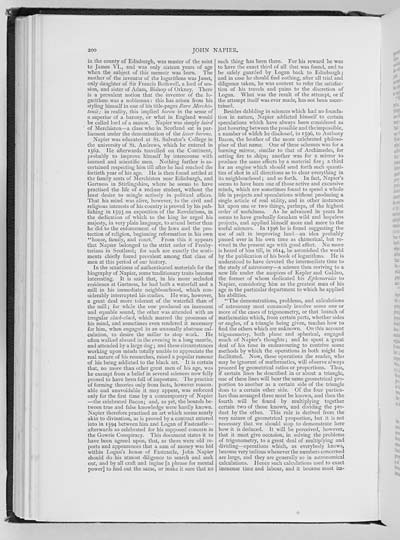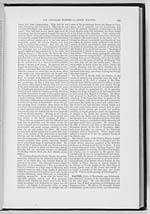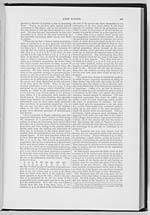2OO
in the county of Edinburgh, was master of the mint
to James VI., and was only sixteen years of age
when the subject of this memoir was born. The
mother of the inventor of the logarithms was Janet,
only daughter of Sir Francis Bothwell, a lord of ses-
sion, and sister of Adam, Bishop of Orkney. There
is a prevalent notion that the inventor of the lo-
garithms was a nobleman: this has arisen from his
styling himself in one of his title-pages Baro Merchis-
tonii; in reality, this implied baron in the sense of
a superior of a barony, or what in England would
be called lord of a manor. Napier was simply laird
of Merchiston�a class who in Scotland sat in par-
liament under the denomination of the lesser barons.
Napier was educated at St. Salvator's College in
the university of St. Andrews, which he entered in
1562. He afterwards travelled on the Continent,
probably to improve himself by intercourse with
learned and scientific men. Nothing further is as-
certained respecting him till after he had reached the
fortieth year of his age. He is then found settled at
the family seats of Merchiston near Edinburgh, and
Gartness in Stirlingshire, where he seems to have
practised the life of a recluse student, without the
least desire to mingle actively in political affairs.
That his mind was alive, however, to the civil and
religious interests of his country is proved by his pub-
lishing in 1593 an exposition of the Revelations, in
the dedication of which to the king he urged his
majesty, in very plain language, to attend better than
he did to the enforcement of the laws and the pro-
tection of religion, beginning reformation in his own
"house, family, and court." From this it appears
that Napier belonged to the strict order of Presby-
terians in Scotland; for such are exactly the senti-
ments chiefly found prevalent among that class of
men at this period of our history.
In the scantiness of authenticated materials for the
biography of Napier, some traditionary traits become
interesting. It is said that, in his more secluded
residence at Gartness, he had both a waterfall and a
mill in his immediate neighbourhood, which con-
siderably interrupted his studies. He was, however,
a great deal more tolerant of the waterfall than of
the mill; for while the one produced an incessant
and equable sound, the other was attended with an
irregular clack-clack, which marred the processes of
his mind, and sometimes even rendered it necessary
for him, when engaged in an unusually abstruse cal-
culation, to desire the miller to stop work. He
often walked abroad in the evening in a long mantle,
and attended by a large dog; and these circumstances
working upon minds totally unable to appreciate the
real nature of his researches, raised a popular rumour
of his being addicted to the black art. It is certain
that, no more than other great men of his age, was
he exempt from a belief in several sciences now fully
proved to have been full of imposture. The practice
of forming theories only from facts, however reason-
able and unavoidable it may appear, was enforced
only for the first time by a contemporary of Napier
�the celebrated Bacon; and, as yet, the bounds be-
tween true and false knowledge were hardly known.
Napier therefore practised an art which seems nearly
akin to divination, as is proved by a contract entered
into in 1594 between him and Logan of Fastcastle�
afterwards so celebrated for his supposed concern in
the Gowrie Conspiracy. This document states it to
have been agreed upon, that, as there were old re-
ports and appearances that a sum of money was hid
within Logan's house of Fastcastle, John Napier
should do his utmost diligence to search and seek
out, and by all craft and ingine [a phrase for mental
power] to find out the same, or make it sure that no
such thing has been there. For his reward he was
to have the exact third of all that was found, and to
be safely guarded by Logan back to Edinburgh;
and in case he should find nothing, after all trial and
diligence taken, he was content to refer the satisfac-
tion of his travels and pains to the discretion of
Logan. What was the result of the attempt, or if
the attempt itself was ever made, has not been ascer-
tained.
Besides dabbling in sciences which had no founda-
tion in nature, Napier addicted himself to certain
speculations which have always been considered as
just hovering between the possible and the impossible,
a number of which he disclosed, in 1596, to Anthony
Bacon, the brother of the more celebrated philoso-
pher of that name. One of these schemes was for a
burning mirror, similar to that of Archimedes, for
setting fire to ships; another was for a mirror to
produce the same effects by a material fire; a third
for an engine which should send forth such quanti-
ties of shot in all directions as to clear everything in
its neighbourhood; and so forth. In fact, Napier's
seems to have been one of those active and excursive
minds, which are sometimes found to spend a whole
life in projects and speculations without producing a
single article of real utility, and in other instances
hit upon one or two things, perhaps, of the highest
order of usefulness. As he advanced in years he
seems to have gradually forsaken wild and hopeless
projects, and applied himself more and more to the
useful sciences. In 1596 he is found suggesting the
use of salt in improving land�an idea probably
passed over in his own time as chimerical, but re-
vived in the present age with good effect. No more
is heard of him till, in 1614, he astonished the world
by the publication of his book of logarithms. He is
understood to have devoted the intermediate time to
the study of astronomy�a science then reviving to a
new life under the auspices of Kepler and Galileo,
the former of whom dedicated his Ephemerides to
Napier, considering him as the greatest man of his
age in the particular department to which he applied
his abilities.
"The demonstrations, problems, and calculations
of astronomy most commonly involve some one or
more of the cases of trigonometry, or that branch of
mathematics which, from certain parts, whether sides
or angles, of a triangle being given, teaches how to
find the others which are unknown. On this account
trigonometry, both plane and spherical, engaged
much of Napier's thoughts; and he spent a great
deal of his time in endeavouring to contrive some
methods by which the operations in both might be
facilitated. Now, these operations the reader, who
may be ignorant of mathematics, will observe always
proceed by geometrical ratios or proportions. Thus,
if certain lines be described in or about a triangle,
one of these lines will bear the same geometrical pro-
portion to another as a certain side of the triangle
does to a certain other side. Of the four particu-
lars thus arranged three must be known, and then the
fourth will be found by multiplying together
certain two of those known, and dividing the pro-
duct by the other. This rule is derived from the
very nature of geometrical proportion, but it is not
necessary that we should stop to demonstrate here
how it is deduced. It will be perceived, however,
that it must give occasion, in solving the problems
of trigonometry, to a great deal of multiplying and
dividing�operations which, as everybody knows,
become very tedious whenever the numbers concerned
are large, and they are generally so in astronomical
calculations. Hence such calculations used to exact
immense time and labour, and it became most im-

![]() Universal Viewer |
Universal Viewer | ![]() Mirador |
Large image | Transcription
Mirador |
Large image | Transcription
![]()

